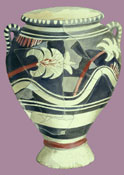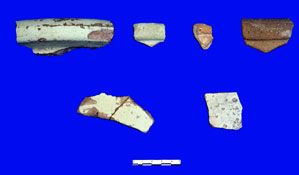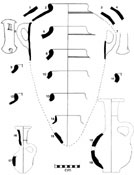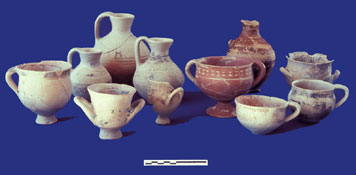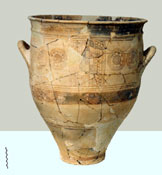 |

The artifact most commonly discovered during excavation at Kommos was pottery. Since pottery forms and decorations change, as one views them in retrospect, in fairly predictable ways, vessel shape and decoration are used to determine relative chronological periods during which they and any associated architecture were created and used. Illustrated in this section on Minoan and Greek pottery are mostly closed shapes (closeable containers) for storage, rather than open shapes used for drinking and eating (bowls, plates, etc.)
|
Kamares Style Piriform Jar The first illustration is a watercolor restoration of a small pithos of Middle Minoan date. It was first covered by a dark wash before other decoration, and then the leaning white palm flowers with incised leaves and trunks were added, as well as wavy bands and white lines. Red was used for the palm trunks, for the center of flowers, a band. The style is called “Kamares’ after a cave on Mount Ida where early explorers discovered examples of similar ceramic containers, now known to be characteristic of fine late Middle Minoan pottery. This pot was discovered in a Middle Minoan storeroom along with dozens of other vessels, some larger and others smaller, along with a collection of stone tools used for food production. The room was revealed largely intact because of a collapse perhaps caused by an earthquake which also left its mark elsewhere on the Kommos site. Above the room was later constructed another Minoan house. |
|
|
Canaanite Jars Some of these came from Syria, such as these three so-called “Canaanite amphoras,” for they are from “Canaan” in the Syria/Palestine area. They were exported to the Aegean with liquids such as wine or oil, and carried resins such as that from pistacia. Many were found in a large affluent mansion, House X, just north of the broad east-west avenue bordering palatial Building T. |
|
|
Cypriot Pithos
This large squat pithos, decorated with a white slip, was used to store foodstuffs, fabrics (on the basis of rural household habits of modern times) and other materials. It was found abandoned along with masses of household pottery in the room of a large house adjacent to the paved east-west road. Especially interesting is that it can be shown to have been made on Cyprus, the great island only a few days’ sail to the east of Crete. No doubt it arrived at Kommos by ship, perhaps directly, and represents only one type of container from Cyprus found at Kommos. Fragments of Cypriot copper ingots were also discovered. Other imported Cypriot goods, manufactured or foodstuffs (e.g. wood, grains) no doubt attracted owners at Kommos but were simply not preserved. |
|
| Fragments of Egyptian Vessels These are vessel fragments from Upper (southern) and Lower (northern) Egypt, a rare find. Although usually no more than sherds, they nevertheless represent the types of everyday vessels brought into the Kommos harbor to be used, then broken by accident and discarded. The first on the left, for instance, is from a portable necked jar. Most of the Egyptian vessels (amphoras, pilgrim flasks) were designed to transport liquids such as oil or wine. Only a few were from open vessels such as bowls. Some may have come directly from Egypt; others may have come via Cyprus. All were found in Late Minoan IA-Late Minoan IIIB contexts. |
|
| Short-necked Amphora and Phoenician Pottery Profiles On the left is a so-called short-necked amphora from a Postpalatial context at Kommos. It was most likely made nearby. While found in houses at the site, many fragments of such closed transport vessels, made to contain liquids such as wine, were also found scattered on the floors of the galleries, the “shipsheds” of Building P (see “The Minoan Palaces and Shipsheds” above). Thus there is every expectation that they were exported, full, to other Cretan and Mediterranean sites, but so far those sites have not been identified during the ongoing search. On the right are profiles of transport vessels of a different nature, Phoenician amphoras from Cyprus or from Levantine sites along the Syria-Palestinian coast. Such vessels at Kommos were associated with post-Minoan, Greek Temple A and its successor, B (see “The Greek Sanctuary”, above) which featured a shrine made up of three tapering pillars set into a base, definitely a Phoenician type known both in Phoenicia itself and in its Punic colonies in the Western Mediterranean. At this point the Kommos shrine is unique in the Aegean, and most likely attests to the early movements of Phoenician merchants and settlers exploring to the West, in this case passing along Crete’s southern shore. It also raises the known date of Phoenician expansion to Crete by perhaps a full century, to c. 900 B.C. |
|
| Proto-geometric Cups and Jugs Much of the ritual in the Greek temples took place in connection with feasting, sacrifice, and liquid offerings made to the patron gods. This may have been concentrated inside the early temples and was later moved out into the open court during later temple phases. Accumulated offerings and ceramic vessels used in the process were often discarded in dumps south of the temple. Also, excavation in the court in front of temples A and B uncovered many of the Protogeometric cups and jugs seen in the illustration. The jugs most likely contained liquids being consumed (wine would be the best choice) or used otherwise (oil for flavor, or for light when placed in lamps). |
|
| Proto-Geometric Krater The Greek Sanctuary was a center for pilgrimage and ritual for over a thousand years. It was a rural establishment, without a surrounding town, so that traces of Greek presence in most of the Minoan town are hardly noticeable. One notable exception is this Protogeometric bell krater, normally used for mixing wine, found above the earlier, Minoan North House next to the site’s northern fence. For excavators expecting only Minoan remains there, the discovery of such an elegant vessel came as a surprise. How did it get there? A burnt layer associated with the vessel suggests that it may have contained the ashes of a human, but that remains unsure. |
|
| Jugs and Aryballoi In the Seventh Century B.C. flasks or aryballoi such as in the illustration became particularly popular for carrying perfumes, oil, and some condiments. They were decorated around their bodies with stripes, and sometimes with concentric circles and pendant fronds on their shoulders. Stoppers probably sealed them. Some of those in the illustration were found within Temple B (see “The Greek Sanctuary” above); others were found discarded in the court outside the temple entrance, to the east. |
